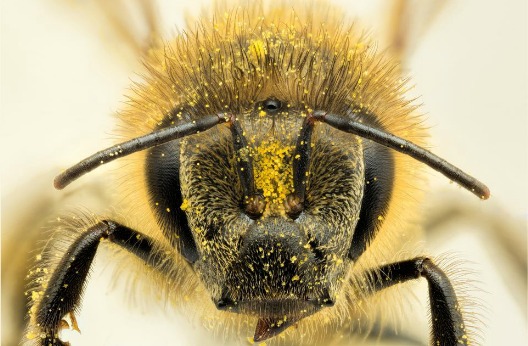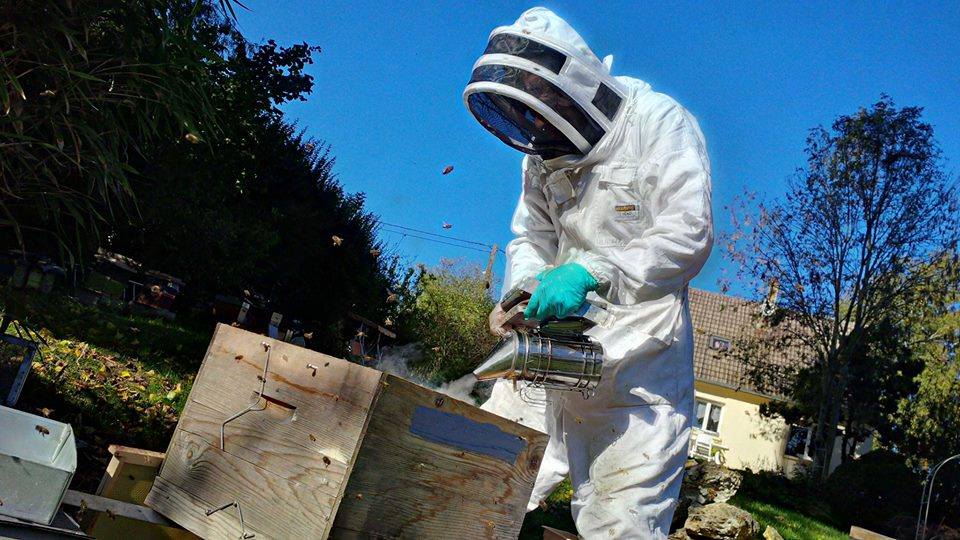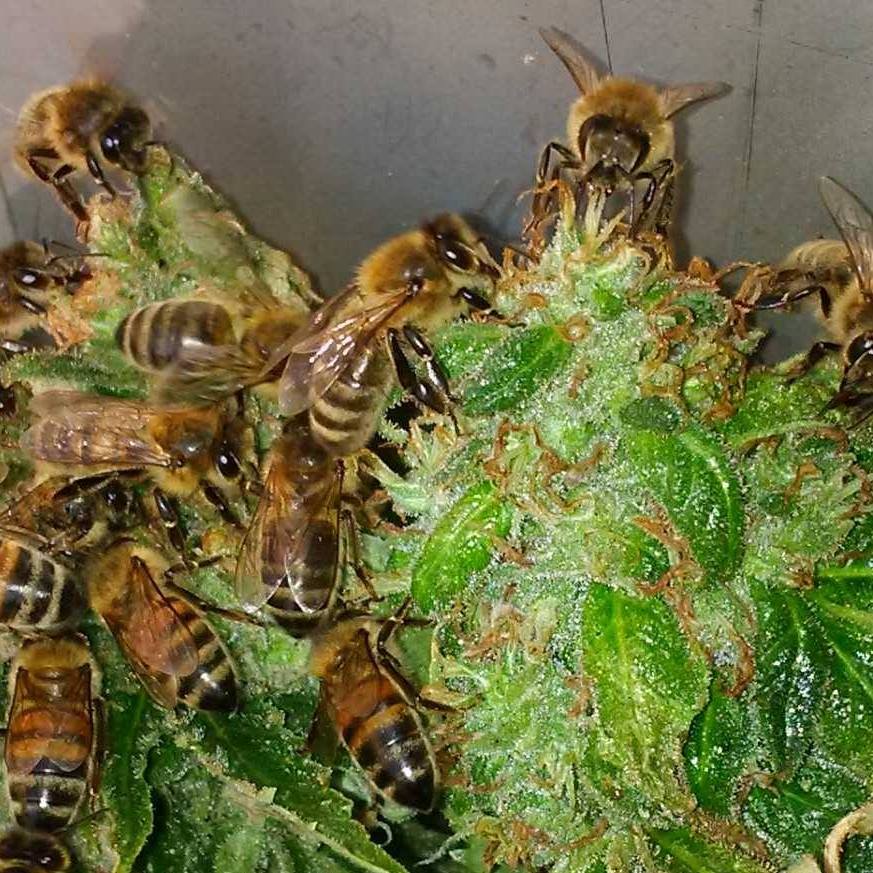“The meaning of Life just may be simply to live life as a bee does with a flower, extract the sweetness without destruction or doing any harm.”
– Dev
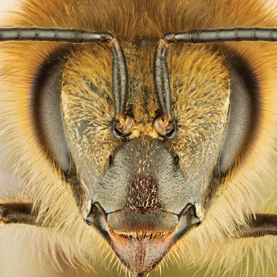
Smile!! 🙂 Honeybees remember faces too.
Bees may have first appeared on earth 30 million years ago….
The work of beekeeping and collecting honey dates as far back as the stone-age, as proved by cave paintings. However, fossils of honey bees found date back around 150 million years!!!
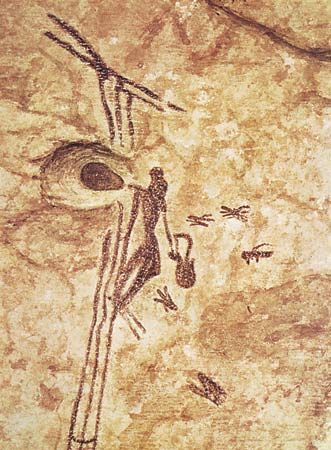
Woman gathering honey, painting in the Cueva de la Arana, near Bicorp, Spain; in the Museum of Prehistory, Valencia, Spain. – Mesolithic (c. 10,000/8000–c. 3000 bce).
Romans used honey as a gift to the gods and used it often in cooking. The Roman empire had many beekeepers. Christianity during this time greatly increased honey and beeswax production to meet the demand for church candles.
Greek recipes books were full of sweetmeats and cakes made from honey. Cheeses were mixed with honey to make cheesecakes, described by Euripides in the fifth century BC as being “steeped most thoroughly in the rich honey of the golden bee.” Greeks wisely viewed honey as not only as very important food, but also as a healing medicine.
Bees were even believed to have special powers and were often used as emblems.
Use of honey was quite significant in Europe, however by the seventeenth century sugar was being used more regularly than honey. ..the decline of honey had begun.
 ..oh they like to Tremble Dance alright ..also they like to get their smoke on too – haha 🙂
..oh they like to Tremble Dance alright ..also they like to get their smoke on too – haha 🙂
“I have trained bees to do several things, such as collect sugar from fruits, instead of using flowers.”
🙂 Honey in the morning honey in the evening honey at suppertime…

A spoonful of honey helps the cannabinoid oil go down 🙂
I prefer a spoonful of honey, ..it helps the cannabinoid oil go down well too. For me, my love for honey goes back to as far back as I can remember… Probably also has something to do with my mother even putting honey on my soother when I was just a baby. Haha 😀 Mmmmmm honey how I do love thee.
Lets look at a few things including the anticancer benefits that one may receive from natural honey…
A Review on Antiproliferative and Apoptotic Activities of Natural Honey.
 “Apoptosis is programmed cell death through which body maintains homeostasis or kills cancer cells by utilizing its cell machinery. Recent researches have concluded that dietary agents have a putative role in instituting apoptosis of cancer cells. Honey, one of the victuals rich in antioxidants, has a long-standing exposure to humans and its role in cancer prevention and treatment is a topic of current interest. Various researchers have been experimenting honey against different cancers and provided valuable insights about the apoptosis induced by the honey. This review will highlight the recent findings of apoptotic mechanism involved in different cancer cells. Further it also reports antitumor activity of honey in some animal models. Hence it is high-time to initiate more preclinical trials as well as clinical experiments which would further add to the knowledge of anticancer nature of honey and also endorse honey as a potential candidate in the war against cancer.”
“Apoptosis is programmed cell death through which body maintains homeostasis or kills cancer cells by utilizing its cell machinery. Recent researches have concluded that dietary agents have a putative role in instituting apoptosis of cancer cells. Honey, one of the victuals rich in antioxidants, has a long-standing exposure to humans and its role in cancer prevention and treatment is a topic of current interest. Various researchers have been experimenting honey against different cancers and provided valuable insights about the apoptosis induced by the honey. This review will highlight the recent findings of apoptotic mechanism involved in different cancer cells. Further it also reports antitumor activity of honey in some animal models. Hence it is high-time to initiate more preclinical trials as well as clinical experiments which would further add to the knowledge of anticancer nature of honey and also endorse honey as a potential candidate in the war against cancer.”
- Chronic inflammation is linked to cancer formation. Excessive or prolonged inflammation can prevent healing by damaging tissues. Honey exhibits anti-inflammatory anti-inflammatory response.
- The antitumor effect of honey may be attributed to its antioxidant Activity. An enhanced antioxidant status with apoptosis has been observed in hepatocellular carcinoma cells. Daily consumption of 1.2 g/kg body weight of honey has been shown to elevate the amount and the activity of antioxidant agents such as beta-carotene, vitamin C, glutathione reductase, and uric acid.
- Mutagenicity, the ability to induce genetic mutation, is interlinked with carcinogenicity. Honey is shown to have a strong antimutagenic agent and hence has anticarcinogenic property.
- Estrogen is involved in number of cancers. Honey modulates estrogen by its antagonistic action. It may be useful in estrogen-dependent cancers such as breasts and endometrial cancers. Honeys from various floral sources are reported to mediate estrogenic effects via the modulation of estrogen receptor activity.
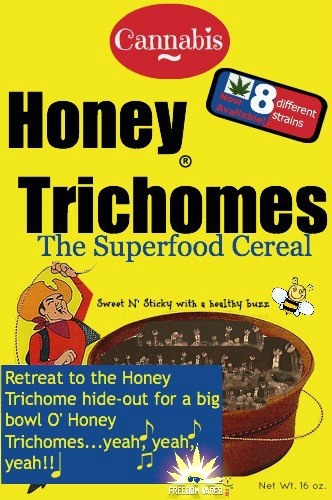 Honey is also an effective treatment for acute cough in children.
Honey is also an effective treatment for acute cough in children.Cough represents one of the most common reasons for pediatrician consultations. Honey provides treatment for symptomatic relief.
In one study out of the Catholic University of Chile, it was concluded that the use of honey probably decreased the severity and frequency of coughs and improved the quality of parent’s and patient’s sleep, and without side effects.
Honey also proves to be a good topical wound care agent owing to a wide spectrum of antimicrobial activity combined with healing properties.
Honey is particularly suitable as a dressing for wounds and burns and has also been included in treatments against pityriasis, tinea, seborrhea, dandruff, diaper dermatitis, psoriasis, hemorrhoids, and anal fissure. In cosmetic formulations, it exerts emollient, humectant, soothing, and hair conditioning effects, keeps the skin juvenile and retards wrinkle formation, regulates pH and prevents pathogen infections.
Honey: A Biologic Wound Dressing. – 
“Honey has been used as a wound dressing for thousands of years, but only in more recent times has a scientific explanation become available for its effectiveness. It is now realized that honey is a biologic wound dressing with multiple bioactivities that work in concert to expedite the healing process.”
“There is good evidence for honey also having bioactivities that stimulate the immune response (thus promoting the growth of tissues for wound repair), suppress inflammation, and bring about rapid autolytic debridement.”
Data from World Health Organization (WHO) shows that 21 million cases of typhoid occur globally every year and over 200,000 die each year; most of them at a very young age. Results of one study conducted at the Department of Microbiology, University of Health Sciences, Lahore, Pakistan suggest that Manuka honey (UMF25±) has a potent anti-typhoid activity. The study also mentions that there is “an intense need for a carefully designed clinical trial in which this therapeutic potential of Manuka honey should be further evaluated. There is also need for the search of local honeys comparable to Manuka honey as a therapeutic option for typhoid fever.”
From the Clinical Investigation Facility, David Grant Medical Center, Travis Air Force Base, Fairfield, California it was concluded as such, “Our in vitro findings support the efficacy of MEDIHONEY against MRSA and A. baumannii as requested by first responders. We also conducted screening assays using other “supermarket brands” of honey. All cultures from the latter showed bacterial and fungal growths. The use of supermarket brand honey for wound treatment is discouraged.”

Lets look at the anticancer benefits alone that one may receive from the cannabinoids found in the cannabis plant. ..imagine the synergy that could be gained when adding cannabinoids to the cancer fighting arsenal.
In the review Anticancer mechanisms of cannabinoids they examine the current understanding of cannabinoids as antitumour agents, focusing on recent discoveries about their molecular mechanisms of action, including resistance mechanisms and opportunities for their use in combination therapy and found “In addition to the well-known palliative effects of cannabinoids on some cancer-associated symptoms, a large body of evidence shows that these molecules can decrease tumour growth in animal models of cancer. They do so by modulating key cell signalling pathways involved in the control of cancer cell proliferation and survival. In addition, cannabinoids inhibit angiogenesis and decrease metastasis in various tumour types in laboratory animals”
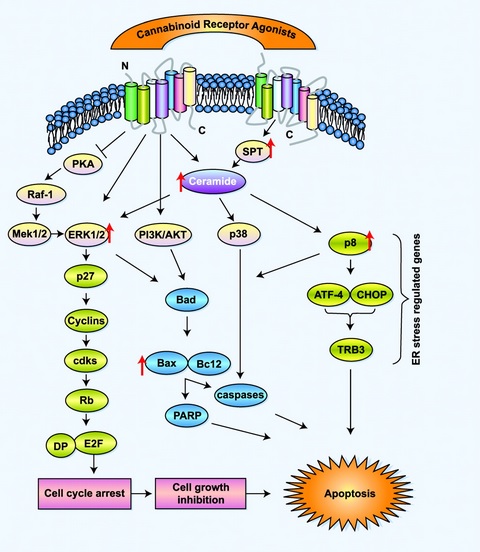 In the study Cannabinoids as therapeutic agents in cancer: current status and future implications they look closely on a broad range of cannabinoids, their receptor dependent and receptor independent functional roles against various cancer types with respect to growth, metastasis, energy metabolism, immune environment, stemness and future perspectives in exploring new possible therapeutic opportunities and mention that “The pharmacological importance of cannabinoids has been in study for several years. Cannabinoids comprise of (a) the active compounds of the Cannabis sativa plant, (b) endogenous as well as (c) synthetic cannabinoids. Though cannabinoids are clinically used for anti-palliative effects, recent studies open a promising possibility as anti-cancer agents. They have been shown to possess anti-proliferative and anti-angiogenic effects in vitro as well as in vivo in different cancer models. Cannabinoids regulate key cell signaling pathways that are involved in cell survival, invasion, angiogenesis, metastasis, etc. There is more focus on CB1 and CB2, the two cannabinoid receptors which are activated by most of the cannabinoids”
In the study Cannabinoids as therapeutic agents in cancer: current status and future implications they look closely on a broad range of cannabinoids, their receptor dependent and receptor independent functional roles against various cancer types with respect to growth, metastasis, energy metabolism, immune environment, stemness and future perspectives in exploring new possible therapeutic opportunities and mention that “The pharmacological importance of cannabinoids has been in study for several years. Cannabinoids comprise of (a) the active compounds of the Cannabis sativa plant, (b) endogenous as well as (c) synthetic cannabinoids. Though cannabinoids are clinically used for anti-palliative effects, recent studies open a promising possibility as anti-cancer agents. They have been shown to possess anti-proliferative and anti-angiogenic effects in vitro as well as in vivo in different cancer models. Cannabinoids regulate key cell signaling pathways that are involved in cell survival, invasion, angiogenesis, metastasis, etc. There is more focus on CB1 and CB2, the two cannabinoid receptors which are activated by most of the cannabinoids”
The role of inflammation in evolution of certain types of cancer has been strongly suggested, linking the inflammatory response to 15–20% of all deaths from cancer worldwide so lets not forget about Cannabinoids as novel *anti-inflammatory drugs from this review they examine the potential use of cannabinoids as a new class of anti-inflammatory agents against a number of inflammatory and autoimmune diseases that are primarily triggered by activated T cells or other cellular immune components.

“According to the World Health Organization, the cases of death caused by cancer will have been doubled until the year 2030.” ” Therefore, it is necessary to explore novel approaches for the treatment of cancer. Over past years, the antitumorigenic effects of cannabinoids have emerged as an exciting field in cancer research. Apart from their proapoptotic and antiproliferative action, recent research has shown that cannabinoids may likewise affect tumor cell angiogenesis, migration, invasion, adhesion, and metastasization…”
Imagine the benefits of adding honey and phytocannbinoids to cancer fighting arsenal.
Canna Honey & Cannabinoid Oil aka RSO (Rick Simpson Oil) – Let Nature Do The Work

Thank you for your interest in this story and thank you for your shares.
OneLove,
Respectfully Freedom Wares
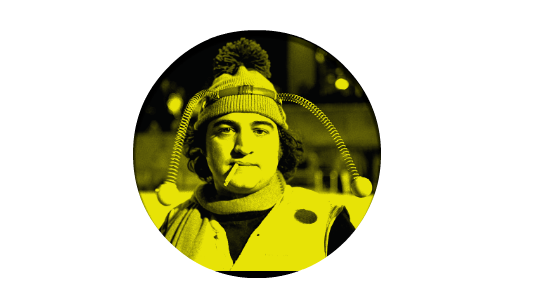
- http://www.ncbi.nlm.nih.gov/pubmed/11447587
- http://www.ncbi.nlm.nih.gov/pubmed/26878302
- http://www.ncbi.nlm.nih.gov/pmc/articles/PMC4417269/
- http://www.ncbi.nlm.nih.gov/pubmed/25193590
- http://www.ncbi.nlm.nih.gov/pubmed/25159357
- http://www.ncbi.nlm.nih.gov/pmc/articles/PMC3925854/
- http://www.ncbi.nlm.nih.gov/pubmed/26004722
- http://www.woundsresearch.com/article/honey-biologic-wound-dressing
- http://www.ncbi.nlm.nih.gov/pubmed/27280298
- http://www.honeyassociation.com/index.asp?pid=9
- https://www.freedomwares.ca/cannabis-extract-treatment-for-terminal-acute-lymphoblastic-leukemia-with-a-philadelphia-chromosome-mutation-2/



